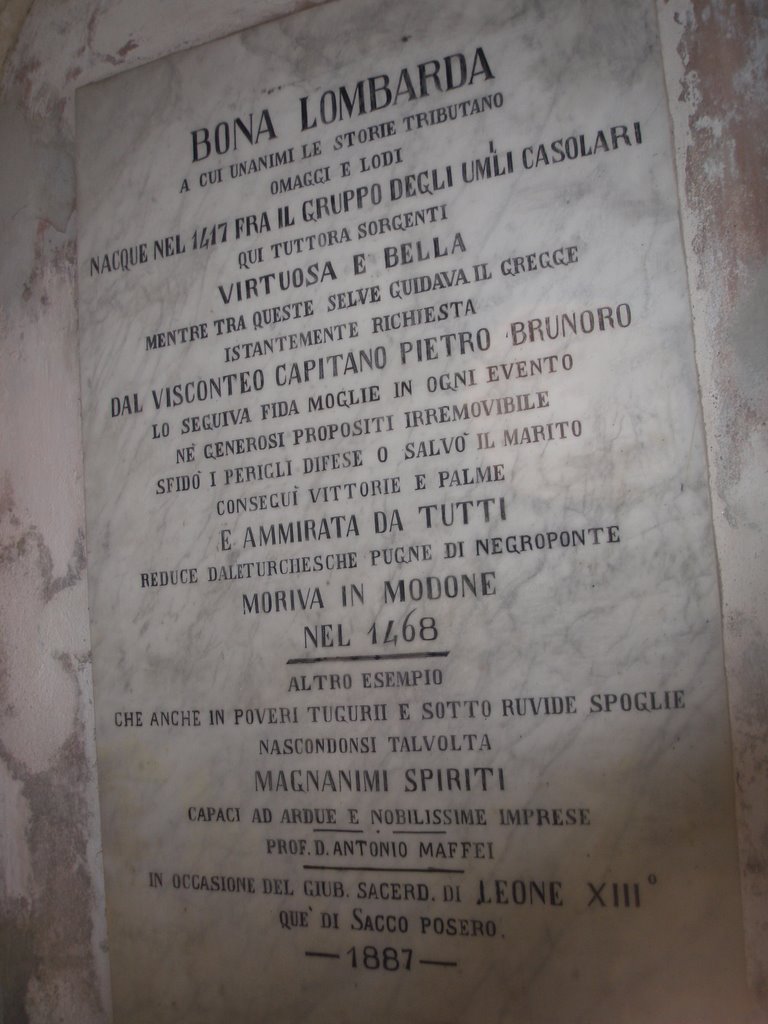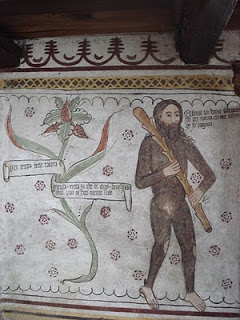Original post: 20 Feb 2014
By Fran Terminiello
We all enjoy stirring stories of derring-do, and accounts of women warriors who defy our expectations of the past are always interesting. A personal favourite is Bona Lombarda, a former peasant girl, who would distinguish herself as a decorated soldier and condottiere. Unfortunately no good account of her life exists in English, so I put together the following a number years ago, and thought I may as well share now.

Perhaps stories of her deeds have been embellished through the years, but the key facts do not appear disputed. She is honoured by a memorial plaque near the house where she was born, in a small sub-alpine Italian village. It reads:
“Bona Lombarda, whom the histories unanimously pay homage to and praise, was born in 1417 among the group of humble farmhouses that still stand here. Virtuous and beautiful, she drove a flock through these woods, until at the request of viscount captain Pietro Brunoro she immediately followed him as faithful wife, unmovable at every event of their noble enterprise. She defied great perils, defended and saved her husband, secured victories and honours. Admired by all, returning as a veteran from the Turkic conflicts of Negroponte, she died in Methoni in 1468. Another example that even in poor hovels and under crude raiments at times are hidden magnanimous spirits capable of arduous and most noble undertakings.”

The only other thing worth noting about the village are contemporary frescoes of a ‘wild man’ uncovered in a notary’s villa.

Pietro Brunoro was an infantry captain, a condottiere in the pay of the Duchy of Milan, the bastard son of a nobleman, and fresh from a crushing victory over the Venetians at the battle of Delebio in November 1432 in which over five thousand Venetians died. On a hunting trip, in the afterglow of victory, he saw a pretty peasant girl herding a flock of sheep “small and brown but otherwise not without beauty”. By some accounts she was abducted, “taken away against her will”, by others there was a seduction. Bona Lombarda was only fifteen at the time, we don’t have a birth date for Pietro Bruno but from the fact he was six years into a forty-two year military career we can surmise he was in his early twenties.
Despite their unorthodox courtship Bona and Pietro became constant companions: “…the woman followed him everywhere, dressing as a soldier and always fighting at his side with a bow.” They campaigned together for eleven glorious years, including one occasion where (Brunoro having changed employers) Bona had the honour of personally parading a captured Milanese standard through Venice. Then disaster struck: Brunoro was imprisoned on charges of treachery by King Alfonso of Naples shortly after joining his employ. Brunoro languished in prison for ten long years. During this time Bona tirelessly petitioned “captains, magistrates and princes whom Brunoro had previously served” obtaining amongst others letters of support from the Grand Duke of Burgundy and the King of France, until Alfonso had no choice but to release Brunoro. Shortly after, they married (or remarried, having previously married in secret in some versions of the tale) and Bona bore him two sons and a daughter. “And with the passing of the years he showed an ever greater deference towards her, asking her advice in every important matter.”

Many more glorious episodes followed, such was their stock Brunoro commanded an astronomical salary of 20,000 ducati from the Venetians. Bona’s most celebrated moment was during the siege of Castello di Pavone (which still stands, now serving as a luxury hotel). The castle had fallen to the enemy Milanese with Brunoro inside it prisoner, his forces scattered. A century later the German historian Johannes Guler Von Weineck described events as follows: “When Castello di Pavone fell, the astuteness and bravery of Bona loomed large, amazing everyone; in fact, after armouring herself head to foot, a shield on her arm and a sword in her hand, she demonstrated great courage during the assault. She was the reason the fortress was retaken and she was the first to place her foot inside.”
And by another account: “She rallied the routed remnants of the troops: she guided them, she encouraged them more by her example than with her voice: she launched herself once more against the Milanese and they fled. She recovered the lost fortress and freed her dear husband.”
Bona won further acclaim when she won the palm as best warrior at the games held in Venice in 1457 to celebrate the inauguration of Doge Pasquale Malipiero, the 66th Doge of Venice, having captured the wooden fortress “defended in vain by able captains and soldiers” – no mean achievement for a “small and brown” former shepherdess who was forty years old at the time. After more than forty years a soldier, Brunoro eventually met his end in battle, having campaigned for eight years against the Turks at Negroponte, in the crumbling fragments of Venice’s empire. But not before presiding over several notable and precious victories, Bona died two years later of fever on the Greek island of Methoni, awaiting a return to Venice.
Read original: http://esfinges1.wix.com/e/apps/blog/women-fighters-from-history-bona-lombarda
